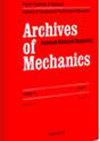n-sided polygonal hybrid finite elements involving element boundary integrals only for anisotropic thermal analysis
IF 1.2
4区 工程技术
Q3 MATERIALS SCIENCE, CHARACTERIZATION & TESTING
引用次数: 0
Abstract
As a combination of the traditional finite element method and boundary element method, the n-sided polygonal hybrid finite element method with fundamental solution kernels, named as HFS-FEM, is thoroughly studied in this work for two-dimensional heat conduction in fully anisotropic media. In this approach, the unknown temperature field within the polygon is represented by the linear combination of anisotropic fundamental solutions of problem to achieve the local satisfaction of the related governing equations, but not the specific boundary conditions and the continuity conditions across the element boundary. To tackle such a shortcoming, the frame temperature field is independently defined on the entire boundary of the polygonal element by means of the conventional one-dimensional shape function interpolation. Subsequently, by the hybrid functional with the assumed intra- and inter-element temperature fields, the stiffness equation can be obtained including the line integrals along the element boundary only, whose dimension is reduced by one compared to the domain integrals in the traditional finite elements. This means that the higher computing efficiency is expected. Moreover, any shaped polygonal elements can be constructed in a unified form with the same fundamental solution kernels, including convex and non-convex polygonal elements, to provide greater flexibility in meshing effort for complex geometries. Besides, the element boundary integrals endow the method higher versatility with a non-conforming mesh in the pre-processing stage of the analysis over the traditional FEM. No modification to the HFS-FEM formulation is needed for the non-conforming mesh and the element containing hanging nodes is treated normally as the one with more nodes. Finally, the accuracy, convergence, computing efficiency, stability of non-convex element, and straightforward treatment of non-conforming discretization are discussed for the present n-sided polygonal hybrid finite elements by a few applications in the context of anisotropic heat conduction.仅用于各向异性热分析的含单元边界积分的n边多边形混合有限元
作为传统有限元方法和边界元方法的结合,本文深入研究了具有基本解核的n边多边形混合有限元方法HFS-FEM,用于完全各向异性介质中的二维热传导。在这种方法中,多边形内的未知温度场由问题的各向异性基本解的线性组合表示,以实现相关控制方程的局部满足,而不是特定边界条件和单元边界上的连续性条件。为了解决这一缺点,通过传统的一维形状函数插值,在多边形单元的整个边界上独立地定义了框架温度场。随后,通过假设单元内和单元间温度场的混合泛函,可以获得仅包括沿单元边界的线积分的刚度方程,与传统有限元中的域积分相比,其维数减少了一。这意味着期望更高的计算效率。此外,任何形状的多边形单元都可以以统一的形式构造,具有相同的基本解核,包括凸多边形单元和非凸多边形单元,以在复杂几何形状的网格划分工作中提供更大的灵活性。此外,与传统的有限元法相比,单元边界积分赋予了该方法更高的通用性,在分析的预处理阶段具有不一致网格。对于不一致网格,不需要修改HFS-FEM公式,并且包含悬挂节点的单元通常被视为具有多个节点的单元。最后,通过在各向异性热传导背景下的一些应用,讨论了n边多边形混合有限元的精度、收敛性、计算效率、非凸单元的稳定性以及不一致离散化的直接处理。
本文章由计算机程序翻译,如有差异,请以英文原文为准。
求助全文
约1分钟内获得全文
求助全文
来源期刊

Archives of Mechanics
工程技术-材料科学:表征与测试
CiteScore
1.40
自引率
12.50%
发文量
0
审稿时长
>12 weeks
期刊介绍:
Archives of Mechanics provides a forum for original research on mechanics of solids, fluids and discrete systems, including the development of mathematical methods for solving mechanical problems. The journal encompasses all aspects of the field, with the emphasis placed on:
-mechanics of materials: elasticity, plasticity, time-dependent phenomena, phase transformation, damage, fracture; physical and experimental foundations, micromechanics, thermodynamics, instabilities;
-methods and problems in continuum mechanics: general theory and novel applications, thermomechanics, structural analysis, porous media, contact problems;
-dynamics of material systems;
-fluid flows and interactions with solids.
Papers published in the Archives should contain original contributions dealing with theoretical, experimental, or numerical aspects of mechanical problems listed above.
The journal publishes also current announcements and information about important scientific events of possible interest to its readers, like conferences, congresses, symposia, work-shops, courses, etc.
Occasionally, special issues of the journal may be devoted to publication of all or selected papers presented at international conferences or other scientific meetings. However, all papers intended for such an issue are subjected to the usual reviewing and acceptance procedure.
 求助内容:
求助内容: 应助结果提醒方式:
应助结果提醒方式:


